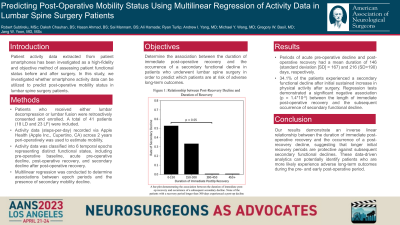Predicting Post-Operative Mobility Status Using Multilinear Regression of Activity Data in Lumbar Spine Surgery Patients
Predicting Post-operative Mobility Status Using Multilinear Regression of Activity Data in Lumbar Spine Surgery Patients
Friday, April 21, 2023


Hasan S. Ahmad, BS
Medical Student
University of Pennsylvania
Philadelphia, Pennsylvania, United States
ePoster Presenter(s)
Introduction: Increasing mobilization is one of the main treatment goals of patients and surgeons in lumbar spine surgery. While traditional subjective outcome assessments in spine surgery cannot quantify patient mobility, directly measuring patient activity data from smartphone accelerometers offers a high-fidelity and objective method of assessing patient functional status before and after surgery. These data can allow surgeons to better understand which patients are and are not likely to experience sustained functional benefits following lumbar spine intervention.
Methods: Patients were retroactively consented and enrolled. Activity data (steps-per-day) recorded in the Apple Health (Apple Inc., Cupertino, CA) over 2 years peri-operatively was classified into 6 temporal epochs representing distinct functional states including pre-operative baseline, acute pre-operative decline, post-operative recovery, and secondary decline after post-operative recovery. Multilinear regression was conducted to determine associations between the epochs and the presence of secondary mobility decline.
Results: A total of 41 patients were included. Periods of acute pre-operative decline and post-operative recovery had a mean duration of 146 (SD=167) and 216 (SD=190) days respectively. 34.1% of the patients experienced a secondary functional decline after initial sustained increase in physical activity after surgery. Regression tests demonstrated a significant negative association (p < 0.001) between the length of immediate post-operative recovery and the subsequent occurrence of secondary functional decline. None of the patients whose recovery lasted longer than 300 days experienced a post-recovery decline.
Conclusion : Our results demonstrate an inverse linear relationship between the duration of immediate post-operative recovery and the occurrence of a post-recovery decline, suggesting that longer initial recovery periods are protective against subsequent secondary functional decline. These data-driven analytics can potentially identify patients who are more likely experience adverse long-term outcomes during the pre- and early post-operative period. More studies are underway to identify other features of activity data that may have implications in predicting outcomes.
Methods: Patients were retroactively consented and enrolled. Activity data (steps-per-day) recorded in the Apple Health (Apple Inc., Cupertino, CA) over 2 years peri-operatively was classified into 6 temporal epochs representing distinct functional states including pre-operative baseline, acute pre-operative decline, post-operative recovery, and secondary decline after post-operative recovery. Multilinear regression was conducted to determine associations between the epochs and the presence of secondary mobility decline.
Results: A total of 41 patients were included. Periods of acute pre-operative decline and post-operative recovery had a mean duration of 146 (SD=167) and 216 (SD=190) days respectively. 34.1% of the patients experienced a secondary functional decline after initial sustained increase in physical activity after surgery. Regression tests demonstrated a significant negative association (p < 0.001) between the length of immediate post-operative recovery and the subsequent occurrence of secondary functional decline. None of the patients whose recovery lasted longer than 300 days experienced a post-recovery decline.
Conclusion : Our results demonstrate an inverse linear relationship between the duration of immediate post-operative recovery and the occurrence of a post-recovery decline, suggesting that longer initial recovery periods are protective against subsequent secondary functional decline. These data-driven analytics can potentially identify patients who are more likely experience adverse long-term outcomes during the pre- and early post-operative period. More studies are underway to identify other features of activity data that may have implications in predicting outcomes.
